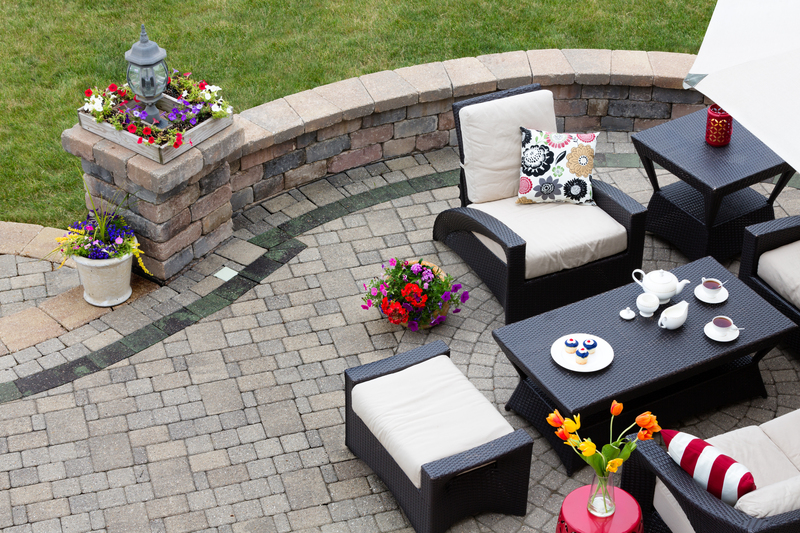Shady Spots Reimagined: Evergreen Climbers to the Fore
Posted on 16/05/2025
Shady Spots Reimagined: Evergreen Climbers to the Fore
Does your garden have shadowy corners, bleak boundaries, or north-facing fences that leave you wondering how to inject beauty into the shade? Many gardeners see shade as an obstacle, but with the right plant choices, shaded spaces can become lush, vibrant, and stunning throughout the seasons. Foremost among your allies are evergreen climbers--hardworking, year-round performers that thrive where others may struggle. In this comprehensive guide, you'll discover how to harness the power of evergreen climbing plants to transform your garden's shady spots into verdant havens.
Why Choose Evergreen Climbers for Shade?
Evergreen climbers are ideal for shaded areas for several compelling reasons:
- Year-round Coverage: They provide constant foliage, ensuring your garden doesn't look bare during winter months.
- Vertical Interest: These climbers uplift walls, fences, pergolas, or trellises, drawing the eye upward and making spaces feel lush--even if horizontal room is limited.
- Habitat & Privacy: Offer shelter for birds and insects, as well as privacy screening all year long.
- Low Maintenance: Once established, most require minimal pruning and are resilient to both cold and low light.
- Versatility: Many varieties flower, offer berries, or present interesting stems, ensuring visual interest whatever the season.
Simply put, evergreen climbing plants for shade are the secret to reimagining those neglected areas of your garden into green sanctuaries.

Understanding Shade: What Counts as a Shady Spot?
Before choosing climbers, it's vital to understand what kind of shade you're dealing with:
- Light Shade: Receives a few hours of sun or dappled light during the day (e.g., under open-canopied trees).
- Partial Shade: 3-6 hours of sun, often morning or afternoon only.
- Full Shade: Little to no direct sun; areas besides north-facing walls, under dense trees, or in alleyways.
Many evergreen climbing plants for shade will thrive in light to partial shade, with some able to handle even true full shade. Always check the requirements of your chosen plant for best results.
Top Evergreen Climbers for Shaded Areas
Here's our curated selection of the most reliable and attractive evergreen climbers for shade gardens, with planting and care advice.
1. Hedera helix (English Ivy)
One of the most iconic and adaptable evergreen climbing vines for shaded spots. Ivy's dense, glossy foliage adds instant greenery to walls and fences.
Care: Thrives in all types of shade. Tolerates poor soils but prefers moist, well-drained conditions. Regular trimming keeps growth in check.
Visual Interest: Varieties like 'Goldheart' or 'Glacier' offer variegated leaves.
Tip: Watch for invasiveness and prune yearly to maintain shape.
2. Trachelospermum jasminoides (Star Jasmine)
Star Jasmine is prized for its glossy, dark green leaves and heavenly scented white flowers. It's more shade-tolerant than many expect, especially in milder climates.
Care: Prefers partial shade; can handle bright shade or filtered sun. Well-drained soils and shelter from cold winter winds suit it best.
Visual Interest: Creamy flowers in late spring to summer.
Bonus: The foliage can bronze in winter, offering extra seasonal interest.
3. Lonicera japonica (Evergreen Honeysuckle)
The Japanese Honeysuckle is a reliable shade-loving evergreen vine with sweetly scented flowers.
Care: Prefers partial to full shade. Loamy soils and occasional feeds help, but it survives in poorer soils too.
Visual Interest: Tubular cream-to-yellow flowers and black berries.
Warning: Keep pruned as it's vigorous; can become dominant if neglected.
4. Clematis armandii ('Armand' Clematis)
Armand's Clematis brings deep green leathery leaves and cascades of early-spring white blossom.
Care: Happy in partial shade; likes roots cool and shaded, keep top growth in brighter conditions if possible.
Visual Interest: Large, fragrant flowers mark the start of spring.
Note: Provide strong support for these vigorous climbers.
5. Pyracantha (Firethorn)
Primarily known as a shrub, Firethorn can be trained against shaded walls where it offers evergreen privacy and autumn berries.
Care: Handles full to partial shade. Tolerates most soil conditions, responds well to regular pruning.
Visual Interest: Fiery berries (red, orange, or yellow) and white spring blossom.
Benefit: Berries attract wildlife; thorny stems deter intruders.
6. Euonymus fortunei (Wintercreeper)
A tough and versatile plant that can climb, trail, or spread. Varieties like 'Emerald Gaiety' and 'Silver Queen' are superb for shaded fences.
Care: Grows in both shade and sun, but prefers a bit of shelter from harsh wind.
Visual Interest: Variegated leaves provide year-round brightness.
Use: Excellent as groundcover where it may root along nodes, but can easily climb supports.
7. Passiflora caerulea (Blue Passionflower)
While not all passionflowers are evergreen, P. caerulea keeps its leaves in milder areas, and handles dappled shade admirably.
Care: Prefers moist, well-drained soils. Can survive brief cold spells, but thrives best with some shelter.
Visual Interest: Exotic blue and white flowers followed by orange fruit.
Tip: Prune after flowering to control size and encourage new blooms.
How to Plant and Care for Evergreen Climbers in Shade
Successful establishment is the key to robust, healthy climbers. Follow these essential tips:
Soil Preparation
- Improve Drainage: Dig ample organic matter such as compost or well-rotted manure into the planting hole. This boosts moisture retention and fertility without risking waterlogging.
- Check pH: Most shade-loving evergreen vines prefer neutral to slightly alkaline soils. Chalky soils suit many types, while acid lovers are fewer.
Planting Technique
- Plant at the Same Depth: Avoid planting too deep--roots should sit at the same depth as in the pot.
- Mulch: After planting, mulch well out to the drip line to preserve moisture and suppress weeds.
- Water: Keep watered in year one while roots establish; beyond that, most evergreens manage with little help.
Supporting Evergreen Climbers
- Trellis or Wires: Many vines need a framework such as a trellis, mesh, or horizontal wires fixed to walls or fences.
- Tie in New Growth: Train shoots while young to encourage coverage of the desired surface.
Pruning and Maintenance Tips
- Light Pruning: Annual trimming is usually sufficient, removing damaged or wayward stems.
- Feed (Optional): A spring feed with a balanced fertilizer can increase vigor, especially in poor soils.
- Inspect for Pests: Aphids or scale may occasionally appear but are rarely major issues for most evergreen climbers.
Creative Uses for Evergreen Climbers in Shade Gardens
With imagination, evergreen climbing plants for shade can bring structure, depth, and surprise to every part of your garden--even to the least-loved spots. Here are some inspiring applications:
- Screening & Privacy: Soften unsightly boundaries or create a natural privacy wall on a shady side of your home or yard.
- Vertical Garden Accents: Frame doorways, windows, sheds or outbuildings that sit in partial shade, adding curb appeal or softening hard lines.
- Understory Layering: Combine climbers on fences with shade-tolerant shrubs, ferns, and groundcovers for a layered woodland effect.
- Shade Pergolas & Arches: Evergreen climbers can trail over pergolas or arches--even those positioned in light-deprived corners--providing year-round shelter and interest.
- Green Backdrops: Transform blank, gloomy walls into leafy tapestries that set off other colorful plants or garden features.
Companion Planting for Maximum Impact
Pairing shade-tolerant evergreen climbers with other shade-loving plants can elevate your garden design:
- Contrast Leaf Shape: Pair finely cut climber leaves with broad leaves of Hosta, Brunnera, or ferns.
- Layered Blooms: Combine climbing jasmine with underplanted hydrangeas or hellebores for a succession of color.
- Neat Edges: Add box or Liriope edging in front of climbing vines for definition and year-round structure.
- Woodland Palette: Ivy or clematis mixed with snowdrops or cyclamen among tree roots for naturalized charm.
Blending evergreen climbers with shade-loving perennials creates a tapestry of texture and hues that rewrites the story of those 'tricky' shaded spots.

Overcoming Common Challenges in Shady, Evergreen Gardens
- Sparse Growth: If your climber languishes, check for root competition, compacted soil, or lack of moisture--shade often means trees nearby which compete for water.
- Poor Flowering: Some flowering climbers bloom better with a little indirect sun; prune lightly and feed in spring to encourage blooms.
- Pest Outbreaks: Shaded areas may harbor slugs or snails. Keep mulch away from stems and check plants regularly.
- Fungal Problems: Good air circulation is a must. Avoid crowding climbers and prune dense growth as needed.
With a little care and savvy plant selection, most problems in shady spots can be avoided or corrected--ensuring long-lasting green success.
Conclusion: Let Evergreen Climbers Lead the Way in Shady Spots
No longer should north-facing walls, fence lines under trees, or sides of your home languish in dull obscurity. By bringing evergreen climbers for shade gardens to the fore, these spaces can become the quiet stars of your landscape. Whether you desire fragrance, color, lush privacy, or wildlife value, there is a shade-tolerant climber perfectly suited for your needs.
Reimagine your shady spaces. Choose the right evergreen climbing plants for shade, implement thoughtful pairing and care, then watch as these green guardians transform your garden, one vertical canvas at a time.
Ready to revitalize your garden's shaded corners? Unleash the potential of evergreen climbers--they are the key to beautiful, thriving shade gardens all year round.

